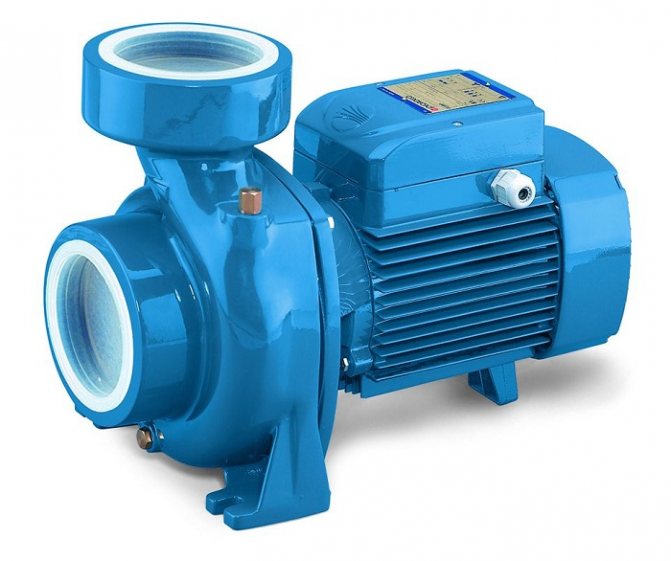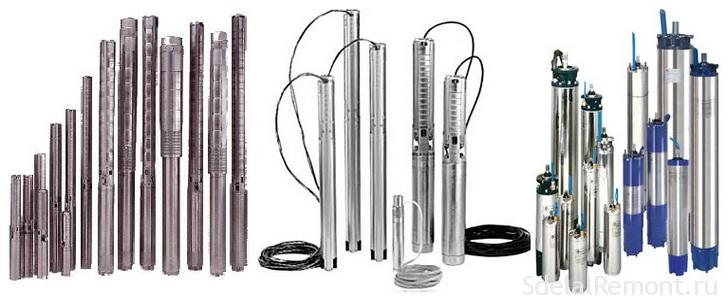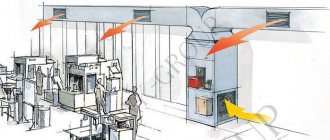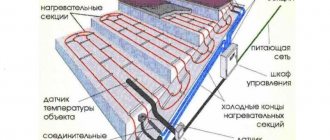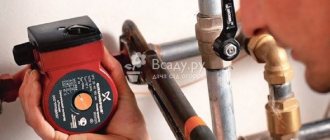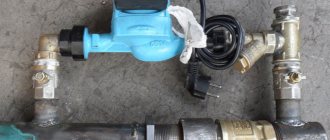How to find out the pump flow rate
The calculation formula looks like this: Q = 0.86R / TF-TR
Q - pump flow rate in cubic meters / h;
R is the thermal power in kW;
TF is the temperature of the coolant in degrees Celsius at the inlet to the system,
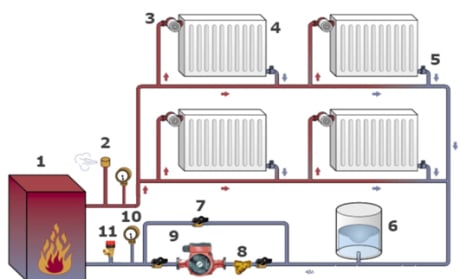
Layout of the heating circulation pump in the system
Three options for calculating thermal power
Difficulties may arise with the determination of the thermal power indicator (R), therefore it is better to focus on generally accepted standards.
Option 1. In European countries, it is customary to take into account the following indicators:
- 100 W / sq. - for private houses of small area;
- 70 W / sq. M. - for high-rise buildings;
- 30-50 W / sq. - for industrial and well-insulated living quarters.
Option 2. European standards are well suited for regions with a mild climate. However, in the northern regions, where there are severe frosts, it is better to focus on the norms of SNiP 2.04.07-86 "Heating networks", which take into account the outside temperature up to -30 degrees Celsius:
- 173-177 W / m2 - for small buildings, the number of storeys of which does not exceed two;
- 97-101 W / m2 - for houses from 3-4 floors.
Option 3. Below is a table by which you can independently determine the required heat output, taking into account the purpose, degree of wear and tear and thermal insulation of the building.


Table: how to determine the required heat output
Formula and tables for calculating hydraulic resistance
Viscous friction occurs in pipes, valves and any other nodes of the heating system, which leads to losses in specific energy. This property of systems is called hydraulic resistance. Distinguish between friction along the length (in pipes) and local hydraulic losses associated with the presence of valves, turns, areas where the diameter of the pipes changes, etc. The hydraulic resistance index is designated by the Latin letter "H" and is measured in Pa (pascal).
Calculation formula: H = 1.3 * (R1L1 + R2L2 + Z1 + Z2 +…. + ZN) / 10000
R1, R2 denote the pressure loss (1 - at the supply, 2 - at the return) in Pa / m;
L1, L2 - length of the pipeline (1 - supply, 2 - return) in m;
Z1, Z2, ZN - hydraulic resistance of system units in Pa.
To make it easier to calculate the pressure loss (R), you can use a special table, which takes into account the possible pipe diameters and provides additional information.
Pressure drop table
Average data for system elements
The hydraulic resistance of each element of the heating system is given in the technical documentation. Ideally, you should use the characteristics specified by the manufacturers. In the absence of product passports, you can focus on the approximate data:
- boilers - 1-5 kPa;
- radiators - 0.5 kPa;
- valves - 5-10 kPa;
- mixers - 2-4 kPa;
- heat meters - 15-20 kPa;
- check valves - 5-10 kPa;
- control valves - 10-20 kPa.
The flow resistance of pipes made of various materials can be calculated from the table below.
Pipe pressure loss table
How to choose a pump according to the parameters "flow" and "head".
The pump selection form is a set of fields with selection filters. Any field of the pump selection filter can be left blank if it is not necessary. In a field group "Pump design" options are grouped in different terminologies. Vibrating is possible only in one field, the rest will be automatically reset to zero.
Switch "Connection" allows to filter pumps with coupling connection from pumps with flange connection. Coupling connection in the context of selection is a connection using any kind of thread, both external and internal.Pumps with optional threaded flanges are also considered to be coupling pumps. A flange connection in the context of selection is any flange connection, including oval flanges.
Switch "Engine" allows you to filter pumps with a three-phase motor from pumps with a single-phase motor. The supply voltage is ignored.
Checkbox "Warehouse only" allows you to filter custom pumps from pumps that may be in a warehouse in Ukraine. The criterion is not one hundred percent, it only shows the trend.
Checkbox "Recommended" will filter pumps with a good price / quality ratio. The filter is very subjective as it is based only on our personal opinion.
Fields "consumption" and "Pressure" have an additional option "priority"... It indicates which parameter should be calculated exactly, that is, if "priority" set on "consumption", then the selection results will include pumps, the hydraulic characteristics of which will exactly match the request in terms of flow, and -15 + 40% of the requested pressure in terms of head.
The selection results display a list of pumps suitable for hydraulic and other parameters, the manufacturer is indicated.
By clicking the link on the name, you can go to the model description page.
We draw your attention to the fact that the form of pump selection does not take into account the level of quality, price policy of manufacturers, popularity of models, delivery time, etc. nuances that are important for making a decision to buy a particular model. For this additional information, we recommend contacting (050) 8132514, (096) 6980735, (0542) 640632 or send a request using the form.
Hello! Tell me which pump to buy ?! From the well to the house is 120 meters, the rise is about 30 degrees. Well 6 meters. Water 2, 5 meters.
In addition to the indicated data, you would also need to know the debit of the well: the amount of water in m3 / h that the aquifer can give out during continuous pumping, the test measurement is usually made within 2-4 hours.
The pump capacity cannot exceed the debit, it must be constantly submerged in water. An expensive pump equipped with dry-running protection will stop working, and a cheap one, without automation, will fail. Judging by the level, your well is quite water-filled, but it doesn't hurt to play it safe.
First, let's estimate what pressure (lifting height) is needed. We will make the calculation using a simplified formula:
H = Hp + (0.2 x L) + 15
Hр - distance from the lower point of the water intake to the upper point of the water supply;
L is the total length of the water supply system;
15 is the recommended correction for maintaining pressure.
Let's say you need to supply water in a house to a height of 10 m.
The height of the well is 6 m. The difference in elevations on the relief with a length of 120 m and an angle of inclination of 30º is 69 m. Hp will be 10 + 6 + 69 = 85 m.
We consider:
Head = 85 m + (0.2 x 120) + 15 = 124 meters
This is a significant value. A household surface pumping station will not raise water to such a height, regardless of where you put it, in a well or in a house.
There remains only a submersible borehole pump, quite powerful.
Inexpensive "Stream" with its maximum rise of 42 m is not for you.
As for the desired performance, an open tap consumes about 6 l / min, a shower - 9 l / min, we will take 25 l / min for watering a garden. With an open tap in the kitchen, shower in the bathroom and simultaneous watering, 40 l / min comes out. This is 2.4 m3 / hour.
Perhaps you do not need such a large volume, if this is not a residential building, but a summer residence.
So, we have a head of 124 meters and a desired flow rate of 2.4 m3 / h.
Why do you need a circulation pump
It is no secret that most consumers of heat supply services living on the upper floors of high-rise buildings are familiar with the problem of cold batteries. It is caused by the lack of necessary pressure. Since, if there is no circulation pump, the coolant moves through the pipeline slowly and as a result cools down on the lower floors
That is why it is important to correctly calculate the circulation pump for heating systems.
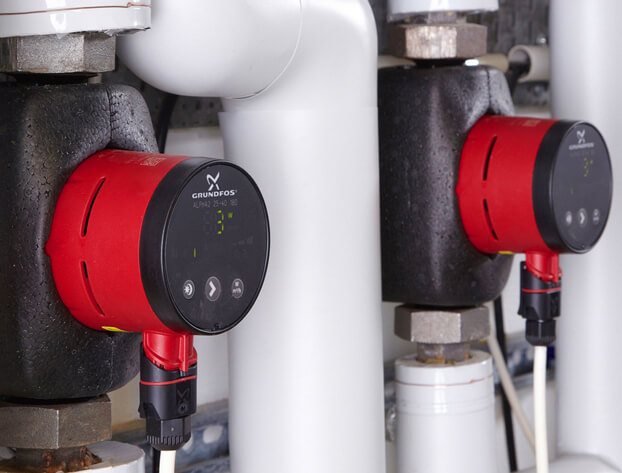

Owners of private households often face a similar situation - in the most remote part of the heating structure, the radiators are much colder than at the starting point. Experts consider the installation of a circulation pump as the best solution in this case, as it looks like in the photo. The fact is that in houses of small size, heating systems with natural circulation of heat carriers are quite effective, but even here it does not hurt to think about purchasing a pump, because if you correctly configure the operation of this device, heating costs will be reduced.
What is a circulation pump? This is a device consisting of a motor with a rotor immersed in a coolant. The principle of its operation is as follows: while rotating, the rotor forces the liquid heated to a certain temperature to move through the heating system at a given speed, as a result of which the required pressure is created.
The pumps can operate in different modes. If you make the installation of a circulation pump in the heating system for maximum work, a house that has cooled down in the absence of the owners can be warmed up very quickly. Then consumers, having restored the settings, receive the required amount of heat at minimal cost. Circulation devices are available with "dry" or "wet" rotor. In the first version, it is partially immersed in the liquid, and in the second - completely. They differ from each other in that pumps equipped with a "wet" rotor make less noise during operation.


Nominal head
The pressure is the difference between the specific energies of water at the outlet of the unit and at the inlet to it.
The pressure is:
- Volume;
- Mass;
- Weighted.


Before buying a pump, you should ask the seller everything about the warranty.
Weighted is important in conditions of a certain and constant gravitational field. It rises with a reduction in the acceleration of gravity, and when weightlessness is present, it equals infinity. Therefore, the weight pressure, which is actively used today, is uncomfortable for the characteristics of pumps for aircraft and space objects.
Full power will be used for starting. It is suitable externally as drive energy for an electric motor or with a flow rate of water, which is supplied to the jet device under special pressure.
Circulation pump speed control
Most models of the circulation pump have a function for adjusting the speed of the device. As a rule, these are three-speed devices that allow you to control the amount of heat that is sent to heat the room. In the event of a sharp cold snap, the speed of the device is increased, and when it gets warmer, it is reduced, while the temperature regime in the rooms remains comfortable for staying in the house.
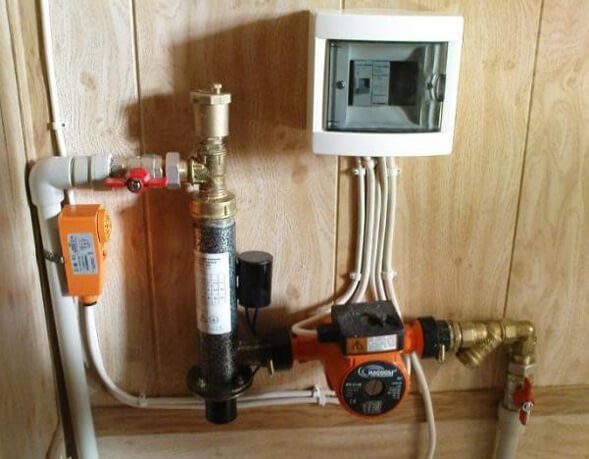

To change the speed, there is a special lever located on the pump housing. Models of circulation devices with an automatic control system of this parameter depending on the temperature outside the building are in great demand.
Design features and principle of operation
Centrifugal pumps are highly efficient and are used for the distillation of various liquids: water, oil, oil, etc. Depending on the field of application, they are divided into two main types:
- industrial;
- household.
Household centrifugal pumps are used to equip the water supply and heating system in their home. To select the optimal model, you should familiarize yourself with the design and principle of operation of the equipment. Such a device consists of the following main assemblies and components:
- electric motor;
- a housing, inside which channels are made in the form of a spiral;
- impeller, depending on technical parameters, there may be several pieces;
- blades;
- inlet and outlet branch pipe.

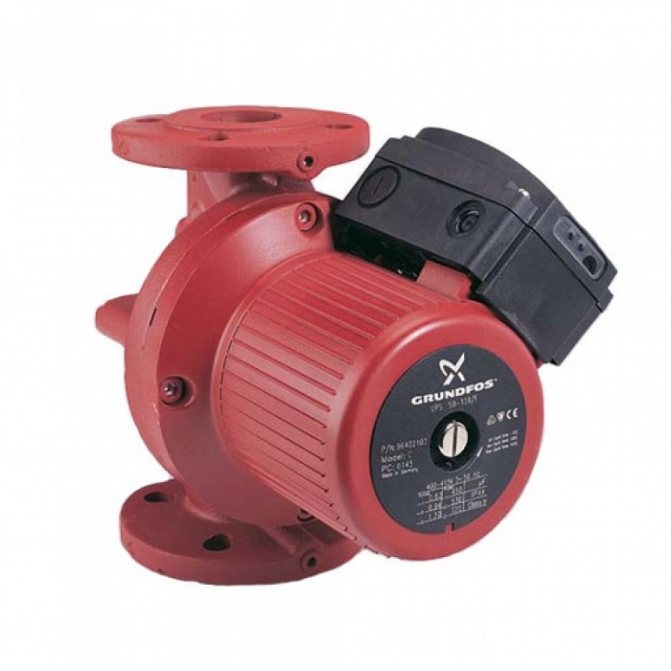
Centrifugal pumps have a simple and reliable design
The operation of a centrifugal pump is based on the physical law of fluid movement through the means of transferring energy to it from a rotating body. The suction pipe and the device body are filled with water Further movement of the liquid is provided by the impeller and blades, which are rigidly connected to the output shaft of the electric motor. When the wheel rotates, centrifugal force arises, which displaces the liquid to the spiral channels of the pump housing, as a result of which an area of increased pressure is formed and water enters the outlet pipe. Then there is a sharp drop in pressure and water is sucked in again through the inlet channel, and the cycle is repeated many times.
Attention! The stable and reliable operation of a centrifugal pump is influenced by such factors as: water quality (hardness, purity, presence of heavy metals), sharp surges and drops in voltage in power lines, low negative temperatures in the winter season.
Selection of a circulation pump for a heating system criteria
When making a choice of a circulation pump for a heating system of a private house, they almost always give preference to models with a wet rotor, specially designed to work in any household mains of various lengths and supply volumes.
Compared to other types, these devices have the following advantages:
- low noise level,
- small overall dimensions,
- manual and automatic adjustment of the number of revolutions of the shaft per minute,
- pressure and volume indicators,
- suitable for all heating systems in individual houses.
Pump selection by number of speeds
To improve the efficiency of work and save energy resources, it is better to take models with a step (from 2 to 4 speeds) or automatic control of the electric motor speed.
If automation is used to control the frequency, then the energy savings in comparison with standard models reach 50%, which is about 8% of the electricity consumption of the whole house.
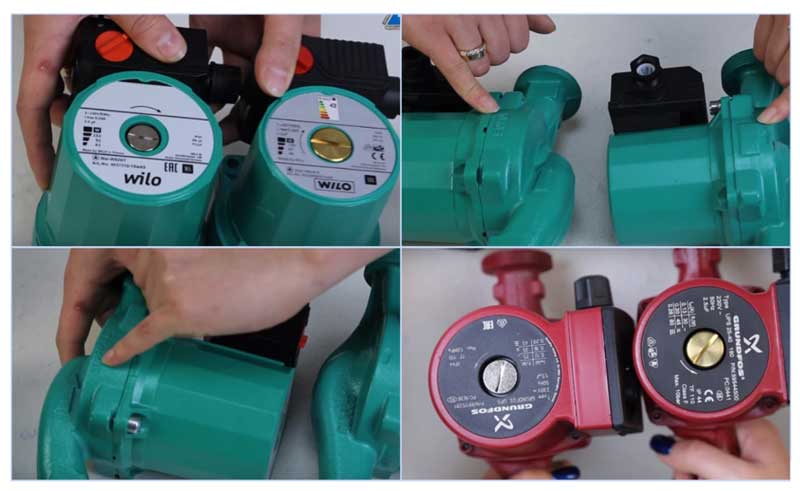

Fig. 8 Distinguishing a counterfeit (right) from the original (left)
What else to pay attention to
When buying popular Grundfos and Wilo models, there is a high probability of a fake, so you should know some of the differences between the originals and their Chinese counterparts. For example, German Wilo can be distinguished from a Chinese counterfeit by the following features:
- The original sample is slightly larger in size, with a serial number stamped on its top cover.
- The embossed arrow of the direction of movement of the liquid in the original is placed on the inlet pipe.
- Air release valve for a fake yellow brass color (the same color in counterparts under Grundfos)
- The Chinese counterpart has a bright shiny sticker on the back indicating the energy-saving classes.


Fig. 9 Criteria for the selection of a circulation pump for heating
Selection of a pump for drainage
The selection of a drainage pump is carried out according to the following parameters:
- Type of pumped liquid (pure water, water with impurities)
- Vertical lift
- Horizontal distance to where fluid is to be pumped
- Required residual liquid level (need to drain completely or residual water level is allowed)
- Required performance
- Pump dimensions (float location - regular float or vertical)
- Automatic or manual operation
Read more about the selection of a pump for drainage >>>
Drainage pumps price list
How to choose and buy a circulation pump
The circulation pumps are faced with some specific tasks, different from water pumps, borehole pumps, drainage pumps, etc. If the latter are designed to move liquid with a specific outlet point, then circulating and recirculating pumps simply "drive" the liquid in a circle.
I would like to approach the selection somewhat non-trivially and offer several options. So to speak, from simple to complex - start with the recommendations of the manufacturers and, lastly, describe how to calculate the circulation pump for heating according to the formulas.
Choose a circulation pump
This simple way to select a circulation pump for heating was recommended by one of the WILO pump sales managers.
It is assumed that the heat loss of the room per 1 sq. M. will be 100 watts. Formula for calculating consumption:
Total heat loss at home (kW) x 0.044 = flow rate of the circulation pump (m3 / hour)
For example, if the area of a private house is 800 sq. M. the required flow rate will be equal to:
(800 x 100) / 1000 = 80 kW - heat loss at home
80 x 0.044 = 3.52 cubic meters / hour - the required flow rate of the circulation pump at a room temperature of 20 degrees. FROM.
From the WILO range, the TOP-RL 25 / 7,5, STAR-RS 25/7, STAR-RS 25/8 pumps are suitable for such requirements.
Regarding the pressure. If the system is designed in accordance with modern requirements (plastic pipes, closed heating system) and there are no non-standard solutions, such as high number of storeys or long heating pipelines, then the pressure of the above pumps should be enough "headlong".
Again, such a selection of a circulation pump is approximate, although in most cases it will satisfy the required parameters.
Choose a circulation pump according to the formulas.
If you want to deal with the required parameters and select it according to the formulas before buying a circulation pump, then the following information will come in handy.
determine the required pump head
H = (R x L x k) / 100, where
H - required pump head, m
L is the length of the pipeline between the most distant points "there" and "back". In other words, it is the length of the largest "ring" from the circulation pump in the heating system. (m)
An example of calculating a circulation pump using the formulas
There is a three-storey house with dimensions of 12m x 15m. Floor height 3 m. The house is heated by radiators (∆ T = 20 ° C) with thermostatic heads. Let's make a calculation:
required heat output
N (from.pl) = 0.1 (kW / sq. M.) X 12 (m) x 15 (m) x 3 floors = 54 kW
calculate the flow rate of the circulation pump
Q = (0.86 x 54) / 20 = 2.33 cubic meters / hour
calculate the pump head
The plastic pipe manufacturer TECE recommends using pipes with a diameter at which the fluid flow rate is 0.55-0.75 m / s, the resistivity of the pipe wall is 100-250 Pa / m. In our case, a 40mm (11/4 ″) pipe can be used for the heating system. At a flow rate of 2.319 cubic meters / hour, the flow rate of the coolant will be 0.75 m / s, the resistivity of one meter of the pipe wall is 181 Pa / m (0.02 m.wc).
WILO YONOS PICO 25 / 1-8
GRUNDFOS UPS 25-70
Almost all manufacturers, including such "giants" as WILO and GRUNDFOS, post on their websites special programs for the selection of a circulation pump. For the aforementioned companies, these are WILO SELECT and GRUNDFOS WebCam.
The programs are very convenient and easy to use.
Particular attention must be paid to the correct entry of values, which often causes difficulties for untrained users.
Buy circulation pump
When buying a circulation pump, special attention should be paid to the seller. Currently, there are a lot of counterfeit products on the Ukrainian market.
How can you explain that the retail price of a circulation pump on the market can be 3-4 times less than that of a representative of the manufacturer's company?
According to analysts, the circulation pump in the domestic sector is the leader in terms of energy consumption. In recent years, the companies have offered very interesting innovations - energy-saving circulation pumps with automatic power control. From the household series, WILO has YONOS PICO, GRUNDFOS has ALFA2. Such pumps consume electricity by several orders of magnitude less and significantly save owners' money costs.
Tools
4 votes
+
Voice for!
—
Against!
When arranging water supply and heating of country houses and summer cottages, one of the most pressing problems is the selection of a pump. A mistake in choosing a pump is fraught with unpleasant consequences, among which the overconsumption of electricity is the simplest, and the failure of a submersible pump is the most common. The most important characteristics by which you need to choose any pump are the water flow rate or pump capacity, as well as the pump head or the height to which the pump can supply water. The pump is not the kind of equipment that can be taken with a margin - "for growth." Everything should be checked strictly according to the needs.Those who were too lazy to make the appropriate calculations and chose the pump "by eye" almost always have problems in the form of failures. In this article, we will dwell on how to determine the pump head and capacity, provide all the necessary formulas and tabular data. We will also clarify the subtleties of calculating circulation pumps and characteristics of centrifugal pumps.
- How to determine the flow and head of a submersible pump
- Calculation of performance / flow of a submersible pump
- Calculation of the head of a submersible pump
- Calculation of a membrane tank (accumulator) for water supply
- How to calculate the head of a surface pump
- How to determine the flow rate and head of a circulation pump
- Calculation of the performance of the circulation pump
- Calculation of the head of the circulation pump
- How to determine the flow and head of a centrifugal pump
How to determine the flow and head of a submersible pump


Submersible pumps are usually installed in deep wells and wells, where a self-priming surface pump cannot cope. Such a pump is characterized by the fact that it works completely immersed in water, and if the water level drops to a critical level, it turns off and does not turn on until the water level rises. The operation of a submersible pump without water "dry" is fraught with breakdowns, therefore it is necessary to select a pump with such a capacity that it does not exceed the debit of the well.
Calculation of performance / flow of a submersible pump
It is not for nothing that the performance of the pump is sometimes called the flow rate, since the calculations of this parameter are directly related to the flow rate of water in the water supply system. In order for the pump to be able to meet the water needs of the residents, its performance must be equal to or slightly higher than the water flow from the simultaneously switched on consumers in the house.
This total consumption can be determined by adding up the costs of all water consumers in the house. In order not to bother yourself with unnecessary calculations, you can use the table of approximate values of water flow per second. The table shows all kinds of consumers, such as a washbasin, toilet, sink, washing machine and others, as well as the water consumption in l / s through them.
Table 1. Consumption of water consumers.


After the costs of all the required consumers have been summed up, it is necessary to find the estimated consumption of the system, it will be slightly less, since the probability of the simultaneous use of absolutely all plumbing fixtures is extremely small. You can find out the estimated flow rate from Table 2. Although sometimes, to simplify the calculations, the resulting total flow rate is simply multiplied by a factor of 0.6 - 0.8, assuming that only 60 - 80% of plumbing fixtures will be used at the same time. But this method is not entirely successful. For example, in a large mansion with many plumbing fixtures and water consumers, only 2 - 3 people can live, and the water consumption will be much less than the total. Therefore, we strongly recommend using the table.
Table 2. Estimated consumption of the water supply system.


The result obtained will be the real consumption of the water supply system of the house, which must be covered by the pump capacity. But since in the characteristics of the pump, the capacity is usually considered not in l / s, but in m3 / h, then the flow rate we obtained must be multiplied by a factor of 3.6.
An example of calculating the flow of a submersible pump:
Consider the option of water supply to a country house, which has the following plumbing fixtures:
- Shower with mixer - 0.09 l / s;
- Electric water heater - 0.1 l / s;
- Sink in the kitchen - 0.15 l / s;
- Washbasin - 0.09 l / s;
- Toilet bowl - 0.1 l / s.
We summarize the consumption of all consumers: 0.09 + 0.1 + 0.15 + 0.09 + 0.1 = 0.53 l / s.
Since we have a house with a garden plot and a vegetable garden, it does not hurt to add a watering tap here, the flow rate of which is 0.3 m / s. Total, 0.53 + 0.3 = 0.83 l / s.
We find from table 2 the value of the design flow: a value of 0.83 l / s corresponds to 0.48 l / s.
And the last thing - we translate l / s into m3 / h, for this 0.48 * 3.6 = 1.728 m3 / h.
Important! Sometimes the pump capacity is indicated in l / h, then the resulting value in l / s must be multiplied by 3600. For example, 0.48 * 3600 = 1728 l / h.
Output: the flow rate of the water supply system of our country house is 1.728 m3 / h, therefore the pump capacity must be more than 1.7 m3 / h. For example, such pumps are suitable: 32 AQUARIUS NVP-0.32-32U (1.8 m3 / h), 63 AQUARIUS NVP-0.32-63U (1.8 m3 / h), 25 SPRUT 90QJD 109-0.37 (2 m3 / h), 80 AQUATICA 96 (80 m) (2 m3 / h), 45 PEDROLLO 4SR 2m / 7 (2 m3 / h), etc. To more accurately determine the appropriate pump model, it is necessary to calculate the required head.
Calculation of the head of a submersible pump
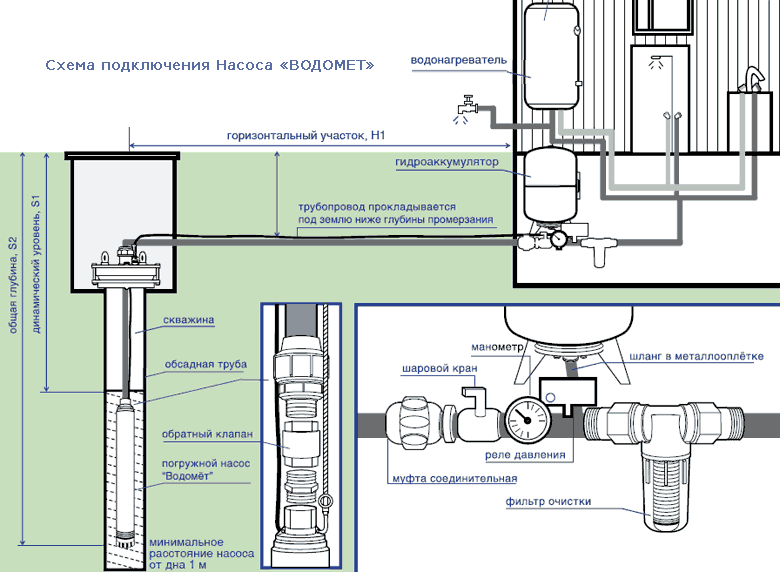

The pump head or water head is calculated using the formula below. It is taken into account that the pump is completely submerged in water, therefore parameters such as the height difference between the water source and the pump are not taken into account.
Calculation of the head of a borehole pump
Formula for calculating the head of a borehole pump:
Where,
Htr - the value of the required head of the borehole pump;
Hgeo - the difference in height between the location of the pump and the highest point of the water supply system;
Hloss - the sum of all losses in the pipeline. These losses are associated with the friction of water against the pipe material, as well as the pressure drop at pipe bends and in tees. Determined by the loss table.
Hfree - free head on the spout. To be able to comfortably use plumbing fixtures, this value must be taken 15 - 20 m, the minimum allowable value is 5 m, but then the water will be supplied in a thin stream.
All parameters are measured in the same units as the pump head is measured - in meters.
The calculation of pipeline losses can be calculated by examining the table below. Please note that in the loss table, the normal font indicates the speed at which water flows through the pipeline of the corresponding diameter, and the highlighted font indicates the head loss for every 100 m of a straight horizontal pipeline. At the very bottom of the tables, losses in tees, elbows, check valves and gate valves are indicated. Naturally, for an accurate calculation of losses, it is necessary to know the length of all sections of the pipeline, the number of all tees, bends and valves.
Table 3. Loss of pressure in a pipeline made of polymeric materials.
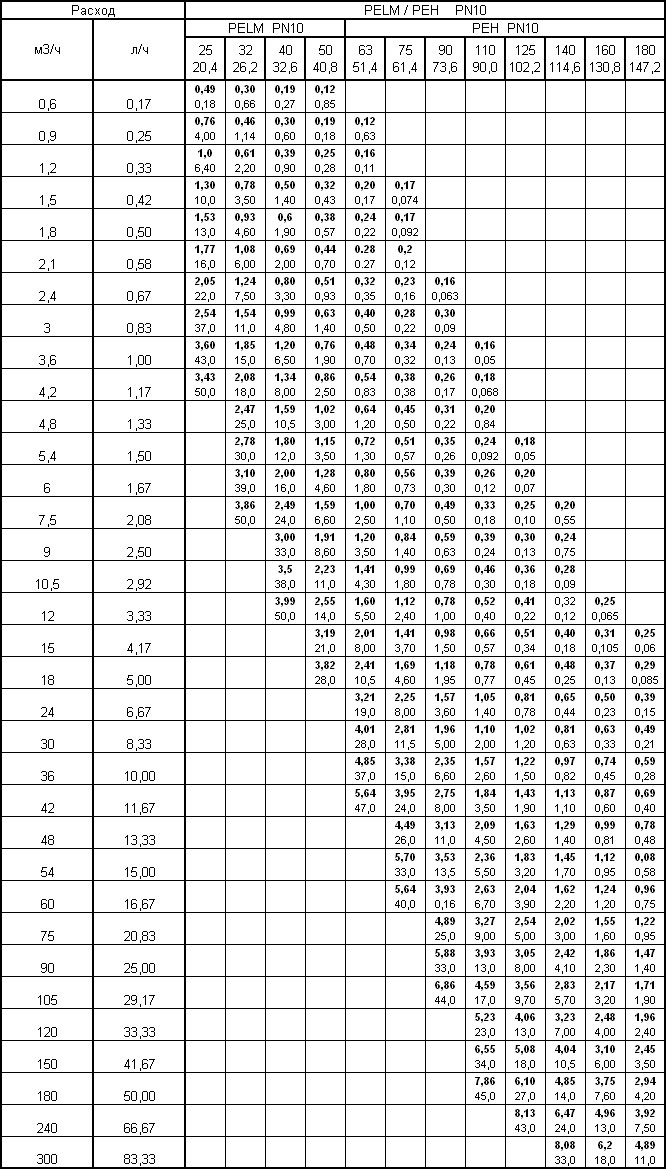

Table 4. Head loss in a pipeline made of steel pipes.
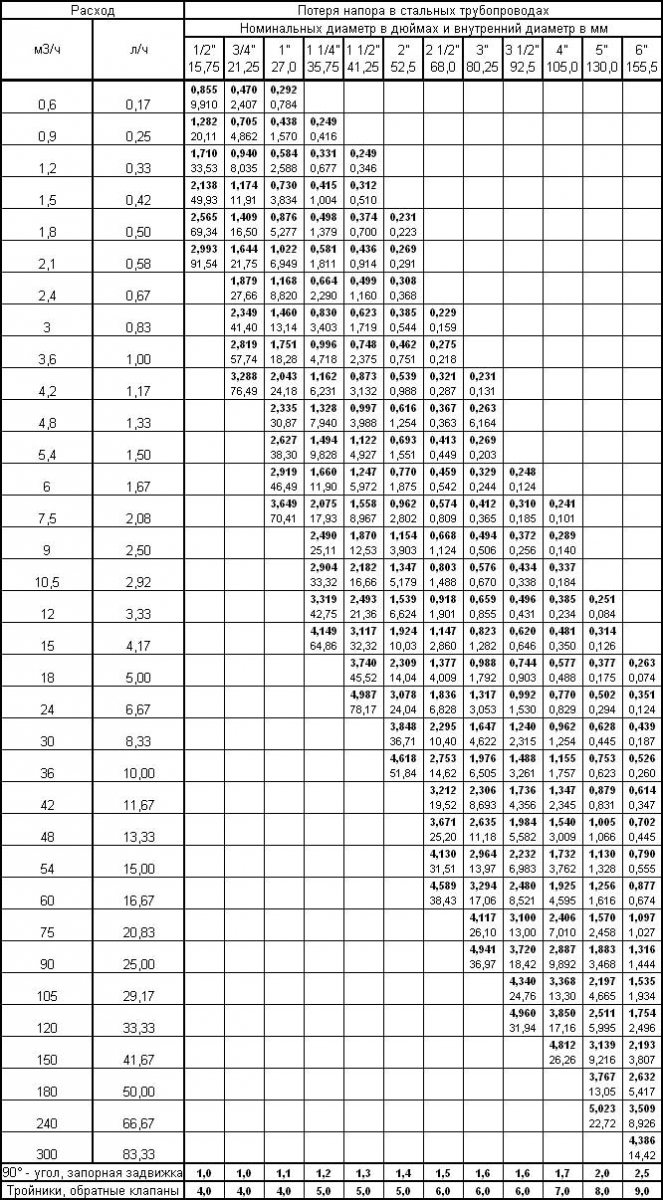

An example of calculating the head of a borehole pump:
Consider this option for water supply to a country house:
- Well depth 35 m;
- Static water level in the well - 10 m;
- Dynamic water level in the well - 15 m;
- Well debit - 4 m3 / hour;
- The well is located at a distance from the house - 30 m;
- The house is two-storey, the bathroom is on the second floor - 5 m high;
First of all, we consider Hgeo = dynamic level + second floor height = 15 + 5 = 20 m.
Further, we consider H loss. Let's assume that our horizontal pipeline is made with a 32 mm polypropylene pipe to the house, and in the house with a 25 mm pipe. There is one corner bend, 3 check valves, 2 tees and 1 stop valve. We will take the productivity from the previous calculation of the flow rate of 1.728 m3 / h. According to the proposed tables, the closest value is 1.8 m3 / h, so let's round up to this value.
Hloss = 4.6 * 30/100 + 13 * 5/100 + 1.2 + 3 * 5.0 + 2 * 5.0 + 1.2 = 1.38 + 0.65 + 1.2 + 15 + 10 + 1.2 = 29.43 m ≈ 30 m.
We will take 20 m free.
In total, the required pump head is:
Htr = 20 + 30 + 20 = 70 m.
Output: taking into account all the losses in the pipeline, we need a pump with a head of 70 m. Also, from the previous calculation, we determined that its capacity should be higher than 1.728 m3 / h. The following pumps are suitable for us:
- 80 AQUATICA 96 (80 m) 1.1 kW - capacity 2 m3 / h, head 80 m.
- 70 PEDROLLO 4BLOCKm 2/10 - productivity 2 m3 / h, head 70 m.
- 90 PEDROLLO 4BLOCKm 2/13 - capacity 2 m3 / h, head 90 m.
- 90 PEDROLLO 4SR 2m / 13 - capacity 2 m3 / h, head 88 m.
- 80 SPRUT 90QJD 122-1.1 (80m) - capacity 2 m3 / h, head 80 m.
A more specific choice of a pump already depends on the financial capabilities of the owner of the dacha.
Calculation of a membrane tank (accumulator) for water supply
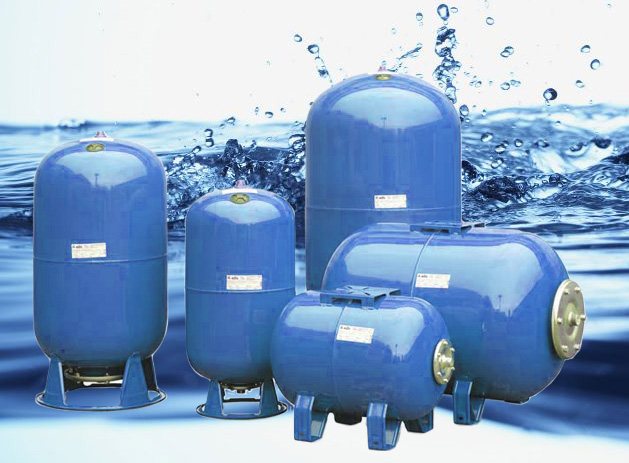

The presence of a hydraulic accumulator makes the pump more stable and reliable. In addition, this allows the pump to turn on less frequently to pump water. And one more plus of the accumulator - it protects the system from hydraulic shocks, which are inevitable if the pump is powerful.
The volume of the membrane tank (accumulator) is calculated using the following formula:
Where,
V - tank volume in l.
Q - nominal flow rate / pump capacity (or maximum capacity minus 40%).
ΔP - the difference between the pressure indicators for switching on and off the pump. Switch-on pressure is equal to - maximum pressure minus 10%. The cut-off pressure is equal to - minimum pressure plus 10%.
Pon - switch-on pressure.
nmax - the maximum number of pump starts per hour, usually 100.
k - coefficient equal to 0.9.
To make these calculations, you need to know the pressure in the system - the pressure of switching on the pump. A hydraulic accumulator is an irreplaceable thing, which is why all pumping stations are equipped with it. The standard volumes of storage tanks are 30 l, 50 l, 60 l, 80 l, 100 l, 150 l, 200 l and more.
How to calculate the head of a surface pump
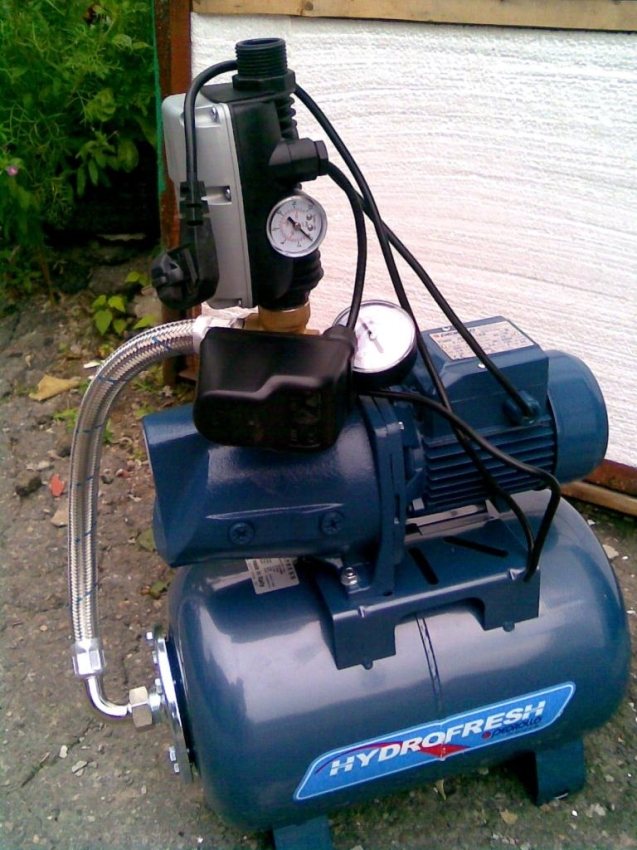

Self-priming surface pumps are used to supply water from shallow wells and boreholes, as well as open sources and storage tanks. They are installed directly in the house or technical room, and a pipe is lowered into a well or other source of water, through which water is pumped up to the pump. Typically, the suction head of such pumps does not exceed 8 - 9 m, but supply water to a height, i.e. the head can be 40 m, 60 m and more. It is also possible to pump out water from a depth of 20 - 30 m using an ejector, which is lowered into the water source. But the greater the depth and the distance of the water source from the pump, the more the pump performance decreases.
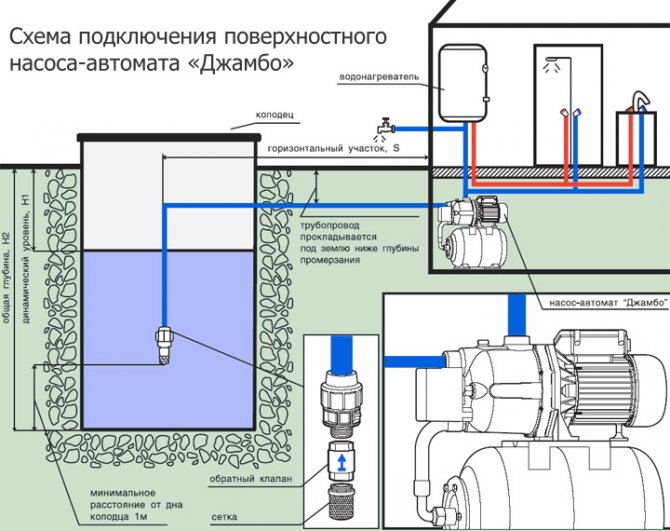

Self-priming pump capacity it is considered in the same way as for a submersible pump, so we will not focus on this again and will immediately move on to the pressure.
Calculation of the pump head located below the water source. For example, the water storage tank is located in the attic of the house, and the pump is on the ground floor or in the basement.
Where,
Ntr - required pump head;
Ngeo - the difference in height between the location of the pump and the highest point of the water supply system;
Loss - losses in the pipeline due to friction. They are calculated in the same way as for a borehole pump, only the vertical section from the tank, which is located above the pump, to the pump itself, is not taken into account.
Nsvob - free head from plumbing fixtures, it is also necessary to take 15 - 20 m.
Tank height - the height between the water storage tank and the pump.
Calculation of the pump head located above the water source - a well or a reservoir, a container.
In this formula, absolutely the same values as in the previous one, only
Source altitude - the difference in height between the water source (well, lake, digging hole, tank, barrel, trench) and the pump.
An example of calculating the head of a self-priming surface pump.
Consider this option for the water supply of a country house:
- The well is located at a distance - 20 m;
- Well depth - 10 m;
- Water mirror - 4 m;
- The pump pipe is lowered to a depth of 6 m.
- The house is two-storied, a bathroom on the second floor is 5 m high;
- The pump is installed directly next to the well.
We consider Ngeo - a height of 5 m (from the pump to the plumbing fixtures on the second floor).
Losses - we assume that the outer pipeline is made with a pipe of 32 mm, and the inner one is 25 mm. The system has 3 check valves, 3 tees, 2 stop valves, 2 pipe bends. The pump capacity that we need should be 3 m3 / h.
Loss = 4.8 * 20/100 + 11 * 5/100 + 3 * 5 + 3 * 5 + 2 * 1.2 + 2 * 1.2 = 0.96 + 0.55 + 15 + 15 + 2, 4 + 2.4 = 36.31≈37 m.
Nfree = 20 m.
Source height = 6 m.
Total, Нтр = 5 + 37 + 20 + 6 = 68 m.
Output: a pump with a head of 70 m or more is required. As the selection of a pump with such a water supply has shown, there are practically no models of surface pumps that would satisfy the requirements. It makes sense to consider the option of installing a submersible pump.
How to determine the flow rate and head of a circulation pump
Circulation pumps are used in home heating systems to provide forced circulation of the coolant in the system. Such a pump is also selected based on the required capacity and pump head. The graph of the dependence of the head on the performance of the pump is its main characteristic.Since there are one-, two-, three-speed pumps, then their characteristics, respectively, are one, two, three. If the pump has a smoothly varying rotor speed, then there are many such characteristics.
The calculation of the circulation pump is a responsible task, it is better to entrust it to those who will carry out the project of the heating system, since for calculations it is necessary to know the exact heat loss at home. The selection of the circulation pump is carried out taking into account the volume of the coolant that it will have to pump.
Calculation of the performance of the circulation pump
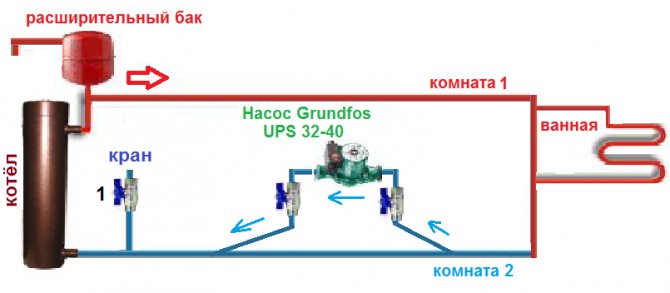

To calculate the performance of the heating circuit circulation pump, you need to know the following parameters:
- Heated building area;
- Heat source power (boiler, heat pump, etc.).
If we know both the heated area and the power of the heat source, then we can immediately proceed to calculating the pump performance.
Where,
Qн - pump delivery / performance, m3 / hour.
Qneobx - thermal power of the heat source.
1,16 - specific heat capacity of water, W * hour / kg * ° K.
The specific heat capacity of water is 4.196 kJ / (kg ° K). Converting Joules to Watts
1 kW / hour = 865 kcal = 3600 kJ;
1 kcal = 4.187 kJ. Total 4.196 kJ = 0.001165 kW = 1.16 W.
tg Is the temperature of the coolant at the outlet of the heat source, ° С.
tx - coolant temperature at the inlet to the heat source (return flow), ° С.
This temperature difference Δt = tg - tx depends on the type of heating system.
Δt = 20 ° C - for standard heating systems;
Δt = 10 ° С - for heating systems with a low temperature plan;
Δt = 5 - 8 ° С - for the "warm floor" system.
An example of calculating the performance of a circulation pump.
Consider this version of a house heating system: a house with an area of 200 m2, a two-pipe heating system, made with a 32 mm pipe, length 50 m. The temperature of the coolant in the circuit has such a cycle of 90/70 ° C. The heat loss of the house is 24 kW.


Output: for a heating system with these parameters, a pump is required with a flow / capacity of more than 2.8 m3 / h.
Calculation of the head of the circulation pump
It is important to know that the head of the circulation pump does not depend on the height of the building, as described in the examples for calculating a submersible and surface pump for water supply, but on the hydraulic resistance in the heating system.
Therefore, before calculating the pump head, it is necessary to determine the resistance of the system.
Where,
Ntr Is the required head of the circulation pump, m.
R - losses in a straight pipeline due to friction, Pa / m.
L - the total length of the entire pipeline of the heating system for the farthest element, m.
ρ - the density of the overflowing medium, if it is water, then the density is 1000 kg / m3.
g - acceleration of gravity, 9.8 m / s2.
Z - safety factors for additional pipeline elements:
- Z = 1.3 - for fittings and fittings.
- Z = 1.7 - for thermostatic valves.
- Z = 1.2 - for a mixer or anti-circulation device.
As it was established through experiments, the resistance in a straight pipeline is approximately equal to R = 100 - 150 Pa / m. This corresponds to a pump head of approximately 1 - 1.5 cm per meter.
The branch of the pipeline is determined - the most unfavorable, between the heat source and the most distant point of the system. It is necessary to add the length, width and height of the branch and multiply by two.
L = 2 * (a + b + h)
An example of calculating the head of a circulation pump. Let's take the data from an example of calculating performance.
First of all, we calculate the branch of the pipeline
L = 2 * (50 + 5) = 110 m.
Htr = (0.015 * 110 + 20 * 1.3 + 1.7 * 20) 1000 * 9.8 = (1.65 + 26 + 34) 9800 = 0.063 = 6 m.
If there are fewer fittings and other elements, then less head will be required. For example, Нтр = (0.015 * 110 + 5 * 1.3 + 5 * 1.7) 9800 = (1.65 + 6.5 + 8.5) / 9800 = 0.017 = 1.7 m.
Output: this heating system requires a circulation pump with a capacity of 2.8 m3 / h and a head of 6 m (depending on the number of fittings).
How to determine the flow and head of a centrifugal pump
The capacity / flow rate and head of a centrifugal pump depend on the number of revolutions of the impeller.
For example, the theoretical head of a centrifugal pump will be equal to the difference in head pressure at the inlet to the impeller and at the outlet from it. The liquid entering the impeller of a centrifugal pump moves in a radial direction. This means that the angle between the absolute speed at the wheel entry and the peripheral speed is 90 °.
Where,
NT - theoretical head of the centrifugal pump.
u - peripheral speed.
c - the speed of fluid movement.
α - the angle referred to above, the angle between the speed at the entrance to the wheel and the peripheral speed, is 90 °.
Where,
β= 180 ° -α.
those. the value of the pump head is proportional to the square of the number of revolutions in the impeller, since
u = π * D * n.
The actual head of a centrifugal pump will be less than the theoretical one, since part of the fluid energy will be spent to overcome the resistance of the hydraulic system inside the pump.
Therefore, the determination of the pump head is made according to the following formula:
Where,
ɳg - hydraulic efficiency of the pump (ɳg = 0.8 - 0.95).
ε - coefficient that takes into account the number of blades in the pump (ε = 0.6-0.8).
The calculation of the head of a centrifugal pump required to provide water supply in the house is calculated using the same formulas that were given above. For a submersible centrifugal pump according to the formulas for a submersible borehole pump, and for a surface centrifugal pump - according to the formulas for a surface pump.
Determining the required pressure and pump performance for a summer cottage or a country house will not be difficult if you approach the issue with patience and the right attitude. A properly selected pump will ensure the durability of the well, the stable operation of the water supply system and the absence of water hammer, which is the main problem of choosing a pump "with a large margin of eye". The result is constant water hammer, deafening noise in the pipes and premature wear of the fittings. So do not be lazy, calculate everything in advance.
Checking the selected motor a. Checking the duration of the rudder shift
For the selected pump, look at the graphs of the dependence of the mechanical and volumetric efficiency on the pressure generated by the pump (see Fig. 3).
4.1. We find the moments arising on the shaft of the electric motor at different angles of the rudder shift:


,
Where: M
α is the moment on the shaft of the electric motor (Nm);
Q
mouth - installed pump capacity;
P
α is the oil pressure generated by the pump (Pa);
P
tr - pressure loss due to oil friction in the pipeline (3.4 ÷ 4.0) · 105 Pa;
n
n - the number of revolutions of the pump (rpm);
η
r - hydraulic efficiency associated with fluid friction in the working cavities of the pump (for rotary pumps ≈ 1);
η
fur - mechanical efficiency, taking into account friction losses (in oil seals, bearings and other rubbing parts of pumps (see graph in Fig. 3).
We enter the calculation data in table 4.
4.2. We find the rotation speed of the electric motor for the obtained values of the moments (according to the constructed mechanical characteristic of the selected electric motor - see section 3.6). We enter the calculation data in table 5.
Table 5
| α ° | n, rpm | ηr | Qα, m3 / s |
| 5 | |||
| 10 | |||
| 15 | |||
| 20 | |||
| 25 | |||
| 30 | |||
| 35 |
4.3. We find the actual performance of the pump at the obtained speeds of the electric motor


,
Where: Q
α is the actual capacity of the pump (m3 / sec);
Q
mouth - installed pump capacity (m3 / sec);
n
- actual speed of rotation of the pump rotor (rpm);
n
n - rated speed of rotation of the pump rotor;
η
v - volumetric efficiency, taking into account the return bypass of the pumped liquid (see graph 4.)
We enter the calculation data in table 5. Build a graph Q
α
=f(α)
- see fig. four
.
Fig. 4. Schedule Q
α
=f(α)
4.4. We divide the resulting schedule into 4 zones and determine the operating time of the electric drive in each of them. The calculation is summarized in table 6.
Table 6
| Zone | Boundary angles of zones α ° | Hi (m) | Vi (m3) | Qav.z (m3 / sec) | ti (sec) |
| I | |||||
| II | |||||
| III | |||||
| IV |
4.4.1.Finding the distance traveled by the rolling pins within the zone


,
Where: Hi
- the distance traveled by the rolling pins within the zone (m);
Ro
- distance between the axes of the stock and rolling pins (m).
4.4.2. Find the volume of oil pumped within the zone


,
Where: Vi
- the volume of the pumped-over oil within the zone (m3);
m
cyl - the number of pairs of cylinders;
D
- diameter of the plunger (rolling pin), m
4.4.3. We find the duration of the rudder shift within the zone


,
Where: ti
- the average duration of the rudder shift within the zone (sec);
Q
Wed
i
- average productivity within the zone (m3 / sec) - we take from the graph p. 4.4. or we calculate from table 5).
4.4.4. Determine the operating time of the electric drive when shifting the rudder from side to side
t
lane
= t1+ t2+ t3+ t4+ to
,
Where: t
lane - the time of shifting the rudder from side to side (sec);
t1÷t4
- the duration of the transfer in each zone (sec);
to
- time of preparation of the system for action (sec).
4.5. Compare t shifts with T (time of rudder shifting from side to side at the request of PPP), sec.
t
lane
≤T
(30 sec)
Basic Rules
Some important aspects when selecting a pump for head and flow rate, namely:
- the amount of hydrogen oxide required (most pumps are suitable for continuous operation);
- productivity, which is determined in liters per minute.
For example, with a capacity of 150 l / min, a bath can be filled in as little as 1 minute.
To determine the required unit, the need for the following indicators is established:
- Determine the flow rate.
- Calculate the statistical head.
- Determine the coefficient of friction, which depends on the flow rate, size and length of the pipe.
- Select the type and model of the pump.
The main parameters that determine the choice:
- computing power or performance;
- lifting height.
The pump capacity is called the flow required to meet the water demand. The demand for drinking fluid depends on the number of consumers:
- for a small building (kitchen, bathroom) - 0.63 l / s (2.5 m3 / h);
- for large houses (kitchen, two bathrooms, laundry) - 0.84 l / s (3.0 m3 / h).
The volume of wastewater will be slightly higher, since it also depends on the use of the toilet:
- in small dwellings - 1.54 l / s (5.54 m3 / h);
- in large houses - 1.94 l / s (6.98 m3 / h).
The daily requirement (with the daily amount of wastewater) averages approximately 150 liters per person or for 4-5 persons 1.0-1.5 m3 / h.
The lift level is determined by the geometric sum of the height at which the hydraulic pipe is located, that is, the difference in height between the unit and the upper receiver caused by fluid friction against the inner surfaces of the pipes and changes in flow direction. If a suction model is used, this figure is the difference between the installation of the unit and the soil flow.
Feeding performance of pumping equipment
This is one of the main factors to consider when choosing a device. Supply - the amount of heat carrier pumped per unit of time (m3 / hour). The higher the flow, the greater the volume of liquid that the pump can handle. This indicator reflects the volume of the coolant that transfers heat from the boiler to the radiators. If the flow is low, the radiators will not heat well. If the capacity is excessive, the heating costs of the house will rise significantly.
The calculation of the capacity of the circulation pumping equipment for the heating system can be made according to the following formula: Qpu = Qn / 1.163xDt [m3 / h]
In this case, Qpu is the unit supply at the design point (measured in m3 / h), Qn is the amount of heat consumed in the area that is heated (kW), Dt is the temperature difference recorded on the direct and return pipelines (for standard systems it is 10- 20 ° C), 1.163 is an indicator of the specific heat capacity of water (if a different heat carrier is used, the formula must be corrected).
Sewage pump selection (fecal pump selection)
The selection of a sewage pump is carried out according to the following parameters:
- Pumped liquid type (pumped particle size)
- The presence of a cutting mechanism
- Vertical lift
- Horizontal distance to where fluid is to be pumped
- Required performance
- The diameter of the pipe through which water and faeces will be supplied
Read more about the selection of a pump for the sewage system >>>
Sewerage pumps price list
How to determine the required head of the circulation pump
The head of centrifugal pumps is most often expressed in meters. The value of the head allows you to determine what kind of hydraulic resistance it is able to overcome. In a closed heating system, the pressure does not depend on its height, but is determined by hydraulic resistances. To determine the required pressure, it is necessary to make a hydraulic calculation of the system. In private houses, when using standard pipelines, as a rule, a pump that develops a head of up to 6 meters is sufficient.
Do not be afraid that the selected pump is capable of developing more head than you need, because the developed head is determined by the resistance of the system, and not by the number indicated in the passport. If the maximum pump head is not enough to pump liquid through the entire system, there will be no liquid circulation, therefore, you should choose a pump with a head margin.
.
Determine the required flow rate.
The required flow rate of the liquid pumped by the pump depends on the needs of your project. Determine this value in gallons per minute (gpm = gpm).
The result of the calculation is necessary in order to determine which pumps and pipes you need.
Example: According to an irrigation plan prepared by a gardener, the required flow rate is 10 gpm
* Reference: 1 foot (ft) = 1 foot = 0.3048 m; 50 feet = 50 feet = 15.24 m

